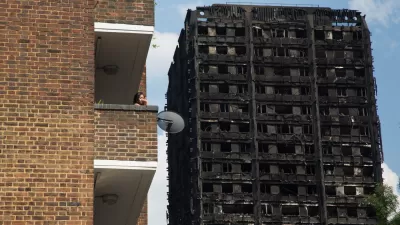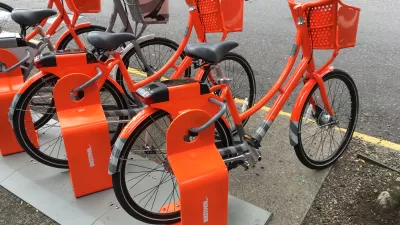The Grenfell Tower Fire in London took the lives of 71 people, and investigators are still searching for lessons from the tragedy. American planners shouldn't neglect these lessons, either.

It often takes a tragedy to start a meaningful conversation. That seems to be the case with the Grenfell Tower fire in London, which claimed the lives of 71 souls. The story can be instructive for citizens and city planners alike if we apply its lessons to the future blueprints of cities. Here are four of the significant lessons that planners and building and construction professionals anywhere in the world can learn the Grenfell Tower Fire.
1. When It Comes to Build Materials, Leave Absolutely Nothing to Chance
It goes without saying that some tragedies — even of this magnitude — are merely accidents. Nevertheless, you usually don't have to look very far to discover hastily-made decisions or corners cut in the name of budgetary savings or convenience.
Exhibit A for cutting corners in the Grenfell Disaster concerns building materials. More specifically, investigators have a lot of questions about the tower's exterior cladding, which was installed in May 2016 as part of a major retrofit of the 1974 building.
To put it simply, the materials chosen for this cladding aren't as fireproof as some of the other available alternatives the building's owners might have chosen instead. There's also a working hypothesis that the addition of this decorative cladding might have contributed a "chimney effect" to the blaze and made it worse.
The lesson here for city planners is twofold. The first is to never build with substandard materials if safer alternatives are also available. The second is not to make changes that serve ornamentation first and utility second.
2. Locate and Design Fire Departments Strategically
Although response time is only one part of the equation in a situation like this one, it's a significant consideration. While some engineers and city planners are looking hard at the Grenfell building itself and the planning — or lack thereof — that went into it, other sets of eyes are looking toward the very future of emergency response planning.
A significant lesson from Grenfell — one which we need to begin implementing immediately, as we start planning tomorrow's cities — is to prioritize making sure emergency response buildings are well-planned.
That means apparent things like distance from major population centers and the number of units per city block, but also the less-obvious features of the buildings housing the fire department, like responsive fire doors and backup power sources that leave nothing to chance when trucks need to roll.
In the wake of criticism against London's fire response during the incident at Grenfell, the British government took direct control, promising an inquiry and review of the existing procedures.
3. Think With Mixed Incomes in Mind
Segregation based on income is one of the worst-kept secrets in America, but similar dynamics contributed to this tragedy in the Grenfell Fire. Regrettably, the Grenfell Fire is just the latest in a long string of tragic circumstances that happen in the portions of cities where high-income neighborhoods meet lower-income communities.
Here is a long-running and measurable statistic: fires like this one are far more likely to claim the lives of the poor and working poor. This was true of Grenfell, and it's been true of many other similar calamities in Australia and throughout the United Kingdom. The ugly truth is, areas where deprivation and unemployment are common are almost always lower priorities for emergency responders. It's not necessarily a choice — it's more often a function of cities having far too many demands on far too few resources.
There's no simple takeaway, either, for the ethics of city planning. But one thing we definitely can do to start moving things in a positive direction — and to address one more form of income and opportunity disparity in America — is to encourage the construction of mixed-income housing. We haven't taken this concept seriously in some time, and now we're paying the price. Since the 1980s, housing developments devoted to the mixed-income model have declined by nearly 10 percent.
Mixed-income pilot programs like the one in Chicago are controversial and haven't yet been studied nationwide in a concerted way, but the early results indicate de-segregating our cities and towns by income delivers better security, safety, and community engagement for all. The more people we have fully engaged in their communities, the less likely it is that anybody's voice — or well-being — will be left out of the conversation.
4. Throw Out the High-Rise Rulebook
It's clear that the skyscraper is a classic symbol of financial might and something we universally associate with success. But the future of city planning might look quite a bit different than it does today.
The Grenfell Tower, as mentioned, was built in the '70s — so it's not a new building. But one thing it underscores is the inherent danger associated with human beings living so "vertically." Densely populated cities have always had very tall buildings, but we seem to have reached diminishing returns.
Beyond the safety concerns amply and tragically demonstrated by Grenfell, there's an economic angle here, as well. Having more mid-rise and low-level buildings seems to stimulate "street-level" interaction in our communities and among our businesses.
In other words, everything we seem to believe about what makes cities genuinely great — superficial impressiveness, chief among them — might reduce our cities' safety and livability rather than enhance it.
It's unfortunate that it takes a story like Grenfell to force us to think differently about something as important as city planning, but it's also great news that we've already begun.

Alabama: Trump Terminates Settlements for Black Communities Harmed By Raw Sewage
Trump deemed the landmark civil rights agreement “illegal DEI and environmental justice policy.”

Planetizen Federal Action Tracker
A weekly monitor of how Trump’s orders and actions are impacting planners and planning in America.

The 120 Year Old Tiny Home Villages That Sheltered San Francisco’s Earthquake Refugees
More than a century ago, San Francisco mobilized to house thousands of residents displaced by the 1906 earthquake. Could their strategy offer a model for the present?

In Both Crashes and Crime, Public Transportation is Far Safer than Driving
Contrary to popular assumptions, public transportation has far lower crash and crime rates than automobile travel. For safer communities, improve and encourage transit travel.

Report: Zoning Reforms Should Complement Nashville’s Ambitious Transit Plan
Without reform, restrictive zoning codes will limit the impact of the city’s planned transit expansion and could exclude some of the residents who depend on transit the most.

Judge Orders Release of Frozen IRA, IIJA Funding
The decision is a victory for environmental groups who charged that freezing funds for critical infrastructure and disaster response programs caused “real and irreparable harm” to communities.
Urban Design for Planners 1: Software Tools
This six-course series explores essential urban design concepts using open source software and equips planners with the tools they need to participate fully in the urban design process.
Planning for Universal Design
Learn the tools for implementing Universal Design in planning regulations.
Clanton & Associates, Inc.
Jessamine County Fiscal Court
Institute for Housing and Urban Development Studies (IHS)
City of Grandview
Harvard GSD Executive Education
Toledo-Lucas County Plan Commissions
Salt Lake City
NYU Wagner Graduate School of Public Service





























